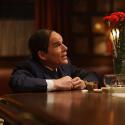The Bigfoot legend rests on something close to found-footage: 1967’s grainy film of a large ape-like creature loping through the remote American North-west. The Patterson-Gimlin expedition’s reels are the Sasquatch conspiracy theorists version of the Zapruder footage. The provocative and prolific writer-director Bobcat Goldthwait took a small crew to the expedition site, the remote epicentre of a tourist trade and local sub-culture built on Bigfoot. Willow Creek’s mixture of quizzical documentary and gripping horror film is the effective result.
 We are entirely in the company of Jim (Bryce Johnson) and Kelly (Alexie Gilmore), pictured right. He’s a Bigfoot believer since childhood, on a birthday quest to film his trek to Willow Creek, and perhaps stumble on something to support his faith. Seeing Bigfoot is, unwisely, his greatest desire. She’s a happy-go-lucky, loving girlfriend supportively along for the trip, but sceptical about giant ape-men wandering even the 21st century USA’s least charted region undetected.
We are entirely in the company of Jim (Bryce Johnson) and Kelly (Alexie Gilmore), pictured right. He’s a Bigfoot believer since childhood, on a birthday quest to film his trek to Willow Creek, and perhaps stumble on something to support his faith. Seeing Bigfoot is, unwisely, his greatest desire. She’s a happy-go-lucky, loving girlfriend supportively along for the trip, but sceptical about giant ape-men wandering even the 21st century USA’s least charted region undetected.
Goldthwait uses the region to his advantage, training the camera on the Bigfoot statues, trinket shops and bars, and folk-art murals which suggest a secret culture of human-Sasquatch interdependence. History and mythology are indicated for this obscure and otherwise unresonant horror monster, but left unexplained. The eccentric locals Goldthwait left his actors to interview include “the Bob Dylan of Bigfoot songs” and the director himself (pictured below left). Initially known as a helium-voiced loose cannon in the Police Academy franchise, his turn as an unstable Bigfoot bookshop owner is a treat. Another local’s invitation to “have a nice slice of pie at the Fuck Off Café” typifies the pungent dialogue, and the idea of a protected, bad secret outsiders would be well-advised not to find.
 Willow Creek also works as an intimate autobiography of a relationship. Jim’s boyish, increasingly dense, stubborn pressing forward into the wilderness is initially indulged by Kelly. There’s a loose, freewheeling feel to their banter. They are a couple who find each other funny, making them necessarily attractive company, with the camera always on them. That camera, operated by the actors to make the footage appear authentically practical, only becomes an irritant as the expedition unravels, and isolation magnifies Jim’s faults. They remain loving, even under duress, making you feel and fear for them in Willow Creek’s second half, when the outside world falls away, and night descends on the forest.
Willow Creek also works as an intimate autobiography of a relationship. Jim’s boyish, increasingly dense, stubborn pressing forward into the wilderness is initially indulged by Kelly. There’s a loose, freewheeling feel to their banter. They are a couple who find each other funny, making them necessarily attractive company, with the camera always on them. That camera, operated by the actors to make the footage appear authentically practical, only becomes an irritant as the expedition unravels, and isolation magnifies Jim’s faults. They remain loving, even under duress, making you feel and fear for them in Willow Creek’s second half, when the outside world falls away, and night descends on the forest.
The film hinges on a 19-minute night-time take, inside a tent, far out on location. Jim and Kelly are woken by noises and movement outside. Their civilised veneers are scraped away gradually, until Kelly, a realist who fully grasps their helpless position, is consumed by fear. Goldthwait tried three takes, during one of which the actors were too freaked out to continue. This sometimes wandering, boring exercise in real-time fright shows what a self-financed two-hander can do, while revealing nothing except its makers’ expertise in human dread. As Jim thought all along, you don’t have to see Bigfoot to believe in him. He keeps the camera running anyway, for the bloodily brief selfie to end them all.














Add comment